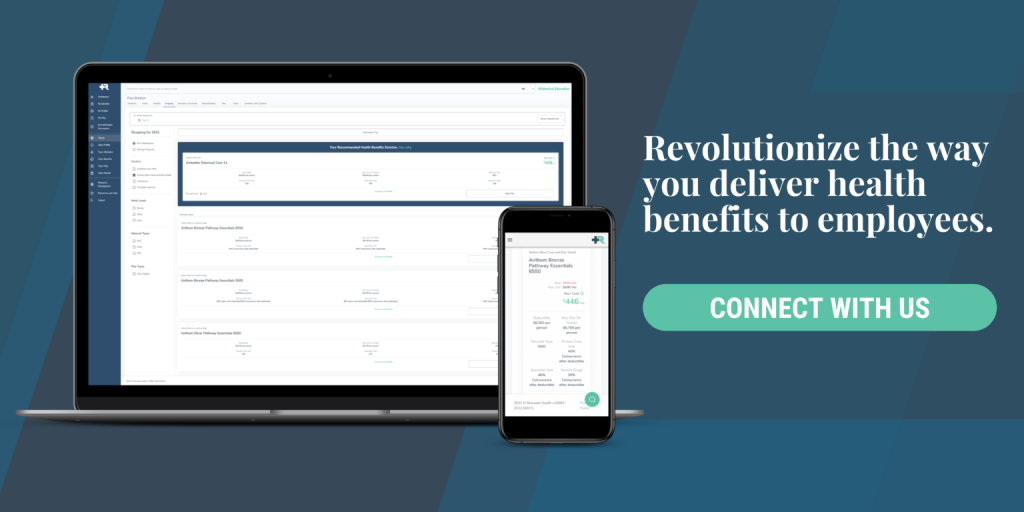In January 2020, we saw the most significant development in health insurance take place since the Affordable Care Act. Individual Coverage HRAs—also called “ICHRA” (ick-ruh)—finally launched after 15 months of coordination between government agencies following a presidential executive order.
Fundamentally, Individual Coverage HRAs allow employers to offer health benefits to their employees in the form of spendable allowances. These allowances are to be used toward premium costs for employees, rather than sponsoring the health insurance product itself.
In the next 3 years, 800,000 employers are projected to leave traditional group plans and move to lCHRA. If you’re interested in learning more about Individual Coverage HRAs, here are the primary things to keep in mind:
1. Old HRA Limitations
Health Reimbursement Arrangement (HRA) first became available to employers with the ERISA Act of 1974. Though ERISA was primarily about retirement benefits, the goal of these HRAs was to allow employers to help employees with their medical costs.
In the early 2000s, rule changes around HRAs allowed them to be used as standalone plans. This means they could be used toward individual medical expenses and monthly premiums. However, when the Affordable Care Act went into effect in 2013, these standalone health reimbursement arrangements were no longer feasible.
This was due to ACA requirements, which stated plans may have no lifetime limits and must also provide minimum essential coverage. Only “integrated” HRAs would be allowed.
This remained true until now, thanks to the new Individual Coverage HRAs.
2. ICHRA Improvements
Individual Coverage HRAs have many rules. However, there are also many freedoms. To start, employers of any size can use ICHRA and it can also fulfill the employer mandate when structured correctly.
Individual Coverage HRAs have also improved the ability to provide customized allowances to employee categories. The ability to organize employees into groups (called “categories”) and then provide unique allowances to each of those groups ensures employers match the needs of all employees.
Lastly, ICHRA allowances do not offset premium tax credits like they did in previous iterations of employer standalone HRAs (such as the QSEHRA). If the Individual Coverage HRA amounts are considered “affordable”, then tax credits are not available to the employee. However, for small employers that don’t have to worry about “affordability” and offer lower ICHRA amounts, tax credits may still be available to the employee. This is a very good thing, because it allows the employee to choose between taking the HRA or taking the tax credit discounts.
Remodel Health’s exclusive ICHRA+™ allows employers to leverage both pre-tax benefits of ICHRA and post-tax benefits (such as tax credit discounts using wage increases). This proprietary approach to employee health benefits allows the employer to provide optimal benefits within an optimal budget.

3. Marketplace Options
The launch of the Individual Marketplace was a bit bumpy. Many people were unsure about individuals choosing their own plans directly from carriers. Thankfully, after 7 years of growth and refinement, the Individual Marketplace now combines perfectly with ICHRA.
Only 1% of employers offer 4 plan options to employees through traditional group health insurance. Most offer even fewer options. However, on the Individual Marketplace, employees often have anywhere from 12 to 36 plans to choose from.
This means employees are able to find a plan that meets their own specific needs. Additionally, the employee owns the plan, meaning it is portable and can go with them should they ever transition out of their current employment. Individual Coverage HRAs help employers care well for their team, while providing greater personal ownership of individual health insurance plans.
4. Medical Expenses
Individual Coverage HRAs can be used by organizations of any size. Additionally, these organizations will not lose tax credits. How ICHRA dollars can be spent is also very flexible.
The reimbursement allowances for ICHRA can be unlimited. This means the employer can determine how much or how little they would like to contribute toward their employees’ healthcare. The dollars are eligible to be used toward medical expenses as defined by U.S. Code § 213.
However, these dollars are not only allowed to be used toward medical expenses; they can also be used toward qualified premiums. Untaxed dollars reimbursed via ICHRA can help employees buy plans.
If you would like to learn more about Individual Coverage HRAs and how you can care better for your team while still cutting costs, be sure to check out our full ICHRA guide. You will be able to evaluate how ICHRA can work for your team, and also find your projected savings using our online calculator.
Our expert team of health benefits consultants are ready to hear from you, so reach out by emailing [email protected] to start rethinking employee health benefits today!

Important Notice: Remodel Health does not intend to provide specific insurance, legal, or tax advice. Remodel Health always recommends consulting with your own professional representation to properly evaluate the information presented and its appropriate application to your particular situation.
